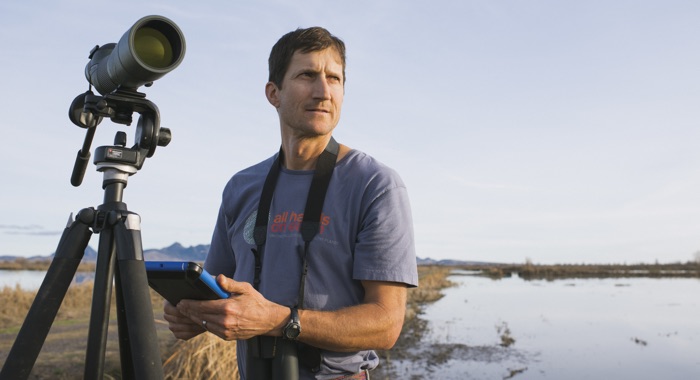California is the leading agricultural state in the country and it’s agriculture generates more than $45 billion annually. About 10 million acres of the state is intensively cultivated land, using roughly 80 percent of the developed water supply. Only a small fraction of these lands are managed deliberately in ways that minimize impacts to nature and maximize the services that nature can provide back to the farm. This has come at a substantial price to nature and the future resilience of agriculture.
Maintaining a mix of natural areas along farm fields and along waterways can provide vital habitat and movement corridors for wildlife, as well as important services like pollination and pest control from native insects, erosion control, and improved water quality. Sustainable management of soils and crops themselves can further reduce the ecological footprint of the land use, and indeed provide habitat for some native species.
Conservancy scientists are investigating these co-benefits, to inform how policy and market incentives could promote food production practices that sustain nature as well as people.


Stephanie Dashiell, Mark Buckley, Dustin Mulvaney
In an effort to address climate change, California enacted a clean energy energy standard that is driving a market for significant amounts of renewable energy. To explore the economic benefits of…Gorm E. Shackelford, Rodd Kelsey, William J. Sutherland, Christina M. Kennedy, Stephen A. Wood, Sasha Gennet, Daniel S. Karp, Claire Kremen, Nathaniel E. Seavy, Julie A. Jedlicka, Kelly Gravuer, Sara M. Kross, Deborah A. Bossio, Andrés Muñoz-Sáez, Deirdre G. LaHue, Kelly Garbach, Lawrence D. Ford, Mark Felice, Mark D. Reynolds, Devii R. Rao, Kathleen Boomer, Gretchen LeBuhn, Lynn V. Dicks
Agricultural management practices impacts not only on crops and livestock, but also soil health, water quality, wildlife, and ecosystem services. There is abundant, but disconnected,…Gorm E. Shackelford, Rodd Kelsey, Lynn V. Dicks
As California and other major agricultural regions around the world tackle the challenge of increasing the sustainability of agriculture to improve environmental health, cover crops are increasingly…Hekia Bodwitch, Jennifer Carah, Kent M. Daane, Christy Getz, Theodore E. Grantham, Gordon M. Hickey, Houston Wilson
Cannabis has been an industry in the shadows for many decades and little studied. In partnership with U.C. Berkeley and U.C. Cooperative Extension, Conservancy staff developed the first cannabis…Houston Wilson, Hekia Bodwitch, Jennifer Carah, Kent Daane, Christy Getz, Theodore E. Grantham, Van Butsic
Cannabis has been an industry in the shadows for many decades and little studied. In partnership with U.C. Berkeley and U.C. Cooperative Extension, the Conservancy staff developed the first cannabis…Grace C. Wu, Emily Leslie, Douglas Allen, Oluwafemi Sawyerr, D. Richard Cameron, Erica Brand, Brian Cohen, Marcela Ochoa, Arne Olson
California has ambitious climate and energy policies that call for the development of significant amounts of new zero-carbon energy by midcentury. The Power of Place study looks at multiple pathways…Jacob E. Lucero, Taylor Noble, Stephanie Haas, Michael Westphal, H. Scott Butterfield, Christopher J. Lortie
Previous work at the Carrizo Plain by this team in 2018 showed that native shrubs facilitated endangered blunt-nosed leopard lizard populations, and should be considered part of plans for habitat…Annika T. H. Keeley, Galli Basson, D. Richard Cameron, Nicole E. Heller, Patrick R. Huber, Carrie A. Schloss, James H. Thorne, Adina M. Merenlender
Connectivity conservation must move more rapidly from planning to implementation. We provide an evidence‐based solution composed of key elements for successful on‐the‐ground…Gregory J. Reis, Jeanette K. Howard, Jonathan A. Rosenfield
For years the narrative of the San Francisco Bay Delta has been driven by the contention that water use by agriculture was being limited by environmental regulation. Analyzing long-term trends…W. David Shuford, Matthew E. Reiter, Kristin A. Sesser, Catherine M. Hickey, Gregory H. Golet
Agricultural intensification has been a major factor in the loss of global biodiversity. Even so, agricultural landscapes provide important habitat for many bird species, particularly in the Central…Joseph A. E. Stewart, H. Scott Butterfield, Jonathan Q. Richmond, David J. Germano, Michael F. Westphal, Erin N. Tennant, Barry Sinervo
Due to limited water resources, there is a global trend toward the retirement of farmland, especially in the San Joaquin Valley in California where the Sustainable Groundwater Management Act could…Annika T H Keeley, David D Ackerly, D Richard Cameron, Nicole E Heller, Patrick R Huber, Carrie A Schloss, James H Thorne, Adina M Merenlender
As climate change impacts wildlife and plants, species may need to access new habitats. Various approaches exist to plan to climate-driven habitat connectivity needs. We summarize the literature of…Kelly Gravuer, Sasha Gennet, Heather L. Throop
Interest in land application of organic amendments—such as biosolids, composts, and manures—is growing among landowners, managers, and climate policy leaders due to their potential to…Michael F. Westphal, Taylor Noble, Harry Scott Butterfield, Christopher J. Lortie
Shrubs can play a key role in the structure of desert communities and can function as foundation species. Understanding desert shrub ecology is therefore an important task in desert conservation. In…David C. Marvin, Dick Cameron, Erik Nelson, Andrew Plantinga, Justin Breck, Gokce Sencan, Michelle Passero
Ecosystems can increase carbon storage under alternative management techniques and land use patterns. But the magnitude, timing, and spatial heterogeneity is uncertain. Assessing the potential and…Van Butsic, Jennifer K. Carah, Matthias Baumann, Connor Stephens, Jacob C. Brenner
While cannabis cultivation in California is known to sometimes have serious collateral impacts on the environment, those impacts and their extent are not well understood or described. In this paper,…Chris Elphick, T. Rodd Kelsey, Catherine Hickey, Khara Strum, Paul Buttner, Monica Iglecia
Wetland birds, especially Sandhill Cranes, are heavily dependent on irrigated farmlands in the Central Valley of California after widespread conversion of natural habitats. TNC and its partners have…Rodd Kelsey, Abby Hart, H. Scott Butterfield, Dan Vink
Restoring habitat in retired farmland could reduce water demand and provide ecosystem services for farmers and local communities. In some areas of California, as a result of the Sustainable…Walter N. Heady, Brian S. Cohen, Mary G. Gleason, Joshua N. Morris, Sarah G. Newkirk, Kirk R. Klausmeyer, Hilary R. Walecka, Elizabeth Gagneron
Sea level rise presents a new challenge to coastal conservation. The authors quantified and mapped the vulnerability of habitats, imperiled species, and conservation lands to sea level rise throughout…